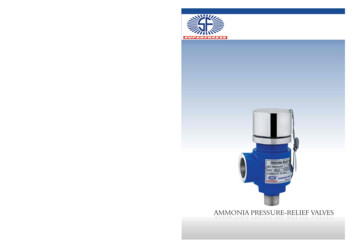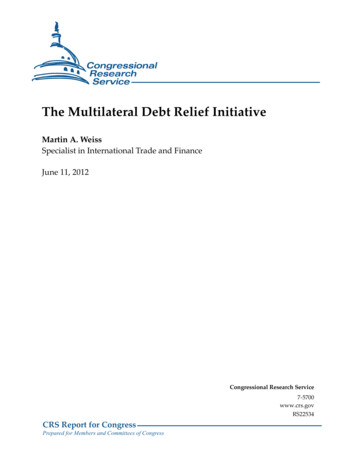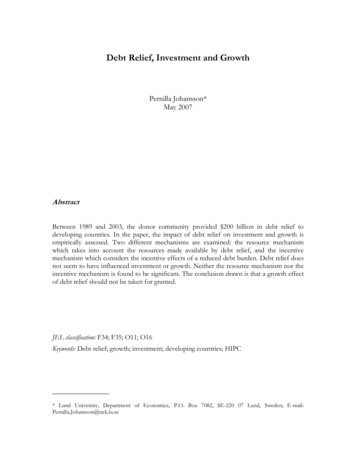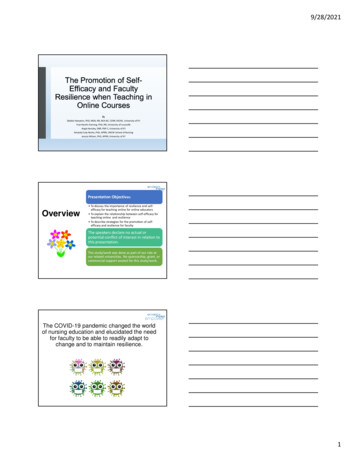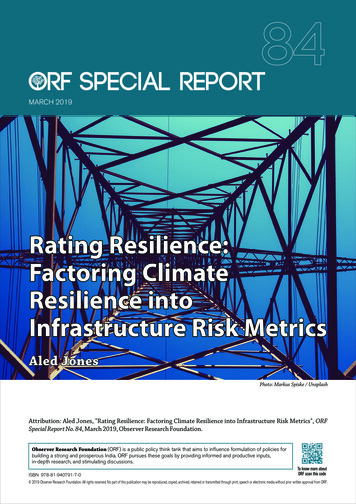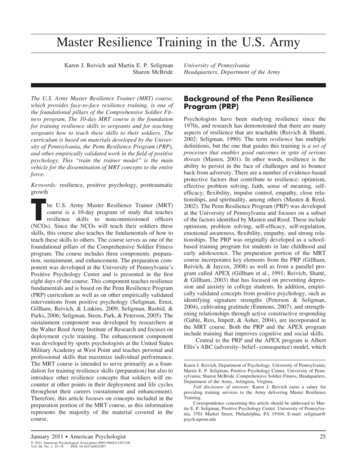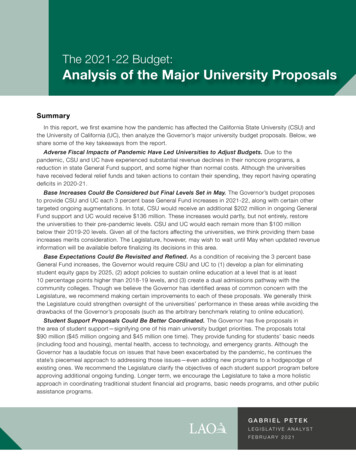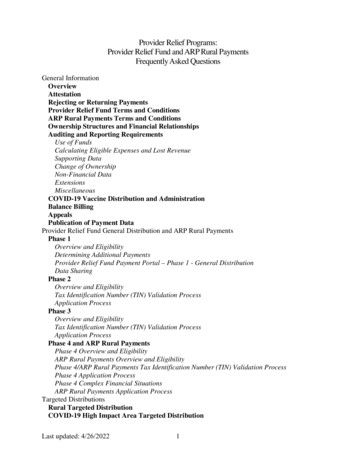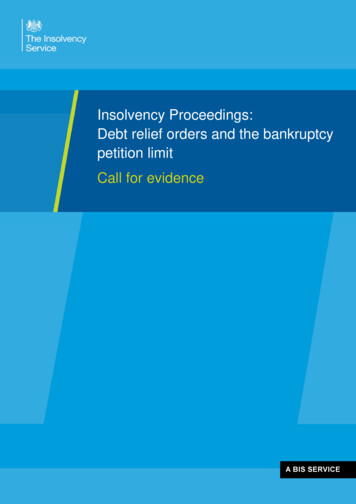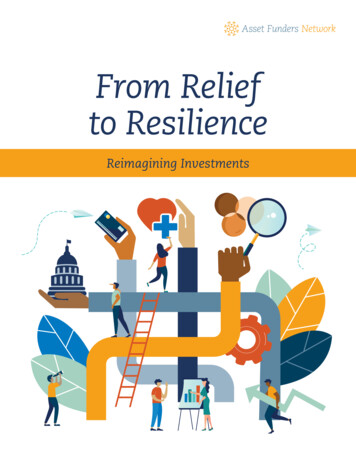
Transcription
From Reliefto ResilienceReimagining Investments
INTRODUCTIONassetfunders.org 2AcknowledgmentsAuthorsCHRISTI BAKERProgram Officer, Asset Funders NetworkAFN EditorsJOE ANTOLINExecutive DirectorANNIKA LITTLEDeputy DirectorJENNIFER FARLANDCommunications DirectorThe authors and AFN would like to thank the following people for sharinginformation about their funding strategies using an equity lens: Cory Anderson,The Winthrop Rockefeller Foundation; Luis Arteaga, Y&H Soda Foundation; VelvetBryant, the Annie E. Casey Foundation; Elena Chavez Quezada, San FranciscoFoundation; Tina Corea, Citi; Cate Costa, JPMorgan Chase; Samuel Diaz,Prudential Financial; Dolores Roybal, Con Alma Health FoundationThe authors and AFN would also like to thank the following funders and stafffor graciously providing insights and advice to inform the project : AlexandraBastien, The Imperative Fund; Velvet Bryant, Alexandra West, and TimothySandoval, the Annie E. Casey Foundation; Elena Chavez Quezada, San FranciscoFoundation; Samuel Diaz, Prudential; Felicia DeHaney, W.K. Kellogg Foundation;Julie Hodgson, Citi Foundation; Dena Jackson, Texas Women’s Foundation;Arielle Milton, Charles Stewart Mott Foundation; Sarah Willis and MiriamFreeman, JPMorgan Chase; Frances Gonzalez, Mona Masri, Karen Murrell, andGabrielle Uballez, Asset Funders NetworkFundersThe findings, interpretations, and conclusions expressed in this brief are the Asset Funder Network’s alone and do not necessarily represent the viewof funders, partners, or those acknowledged.
INTRODUCTIONassetfunders.org 3IntroductionA global pandemic. Massive economic fallout. Police violence and racism. Ongoingsocial unrest. Entrenched political distrust.Financial insecurity and wealth gaps.The events of 2020 revealed unvarnished truths whichdemand that philanthropic organizations take stock ofwhere they have acted and where action is needed to buildeconomic well-being for all. This long-overdue momentemphasizes the critical need for strategies that provide arange of support to people who are struggling due to deepfinancial disparities.The lives, health, and financial well-being of women andBlack, Latinx, Indigenous, and Asian people,1 includingimmigrants, are disparately impacted by societal andeconomic destabilization. Today’s disparities are built on,and exacerbated by, long-standing inequities created bystructural racism, sexism, and classism, which have limitedfinancial security and overall well-being for those affected. Now is the time for philanthropy to lead the way byinvesting in equity on purpose. Philanthropy can help shapethe future of families, communities, and the economy bysupporting the development of a reimagined, more equitable financial system that builds on people’s strengths.Creating a healthier, more equitable society is a multisystem, multisector endeavor. Addressing systemic inequitiesrequires understanding the current and historical landscape, identifying what needs to be modified, and workingcollaboratively across sectors to create needed change. Asinfluencers, leaders, and conveners, philanthropic organizations have a catalytic role to play in the movement forsocial change.1.In the brief, we use specific language regarding race and ethnicity andthe term “people of color” interchangeably. When relevant, we disaggregate by race and refer to specific groups.STRUCTURAL RACISMThe arrangement of institutional, interpersonal, historical, and cultural dynamics that consistently produces advantage for White people and adverse outcomes for Black, Latinx, Indigenous,and Asian people. Structural racism is racism that persists even in the absence of individual racistactors because it is systemically embedded. When the United States was founded, racist principleswere codified in governance structures and policies. As a result, racism is entrenched in institutions,structures, and social relations across American society. Today, structural racism is inherent in intersecting, overlapping, and codependent racist institutions, policies, practices, ideas, and behaviorsthat give an unjust amount of resources, rights, and power to White people while denying them toBlack, Latinx, Indigenous, and Asian people. Structural sexism privileges men and structural classism privileges wealthy people in similar ways.Source: Equity in the Center, AWAKE to WOKE: Building a Race Equity Culture, 2019, https://equityinthecenter.org/aww/
INTRODUCTIONassetfunders.org 4Through its network of grantmakers, theAsset Funders Network (AFN) engagesphilanthropy to advance equitable wealthbuilding and economic mobility.Over the past six years, AFN has published regional scans and over40 original briefs across seven issue domains that are key drivers ofeconomic security and asset building: business ownership, education, employment and income, financial health, health, housing, andwealth gaps. Reducing racial and gender wealth gaps is a theme thatis threaded across all issue areas. Through research, best practices,new approaches, and strategic recommendations, our briefs serve as7 FOCUSAREASfoundations for establishing a common understanding of realities andexpanding needed investments to cultivate thriving communities.Over the years, we have identified numerous strategies for philanthropy to engage with these issues, from debt relief via systemschange that sustainably confronts inequities and structural barriersto financial coaching as a short-term tool to reduce financial stress.BUSINESSOWNERSHIPWEALTH GAPSEDUCATIONEMPLOYMENTAND INCOMEFINANCIALHEALTHHEALTHHOUSINGThis brief responds to the urgencyof this moment, reimagining andbuilding on past recommendationsto map more just paths to economicresilience moving forward.AFN presents a framework andrecommendations for funders thatexplicitly place racial and genderequity at the forefront. At the sametime, we recognize the diverse needsof communities and thus elevate acontinuum of strategies that funderscan apply immediately, in the midterm, and over the long term, bysupporting on-the-ground programsand systemic solutions. Whetheryou have been applying an equitylens for a while or are just startingon this journey, and whether you arewith a family, community, or nationalfoundation or financial institution,we hope that you find a place inthe brief to engage with the work.The brief provides funderswith multiple points of entryto reimagine investments andoperationalize equity. It starts withresearch that makes the case forreimagining. Then, it introducesa framework that centers equity.Recommendations and reflectionquestions for implementationfollow. The brief ends with casestories that provide examplesof equity integration in action.Engaging at any level helps usall eliminate the disparities inour economic system that havepersisted for too long.
CONTEXTassetfunders.org 5Context for theNeed to ReimagineThe massive health and economic crisis offinancially before the pandemic, contending withCOVID-19 exposed and exacerbated underlyinga lack of financial security and limited wealth.disparities in financial wealth and well-being.This context provides background and rationaleDue to structural racism and sexism, manyfor embracing a funding framework that relies onpeople, especially women and Black, Latinx,an equity and antiracist lens.Indigenous, and Asian people, were strugglingBACKDROPCOVID-19 Disparate pathways tofinancial security Wealth gaps H ealth and economiccrisis with uneven impact L ong-lasting impactsunless disruptedROOTS Structural racism and sexism Historical and current economicpolicies and practices thatdiscriminate, exclude, and extract
CONTEXTassetfunders.org 6Pervasive, Growing Financial InsecurityAlthough COVID is a universal public health issue,the nature and magnitude of the pandemic’s healthand economic impacts have been far from universal.Before the current crisis, racial, gender, community,and income lines placed many families in precariousfinancial situations; long-standing structural inequities leftthem with little reserves and few pathways to financialhealth. COVID undeniably exacerbated these disparities.Financial insecurity and hardships for women, Black,Latinx, Indigenous, and Asian people have balloonedduring COVID, as indicated by growing income inequalityalongside with high housing costs, limited savings, andincreased debt among these vulnerable populations. Theseindicators are interconnected and have ripple effects acrossfamilies, communities, and the economy as a whole.INCOME INEQUALITY AND OCCUPATIONAL SEGREGATIONContributing to financial insecurity are wage and benefit gaps driven by systemic inequities for womenand Black, Latinx, Indigenous, and Asian people, as well as broader economic trends of declining laborshare of income and growing income inequality. The wages paid are often not sufficient to cover thebasic costs of living, and the jobs held by women, Black, Latinx, Indigenous, and Asian people havebeen vulnerable to COVID.INNEARLY HALFOF ALL WORKERSwho were deemed essential in 2020earned less than a living wage.1COVIDHAS IMPACTED THEwhich employs one in four workers,2 whoare predominantly women and Black, Latinx andAsian people. These workers have faced healthrisks, limited worker protections, and layoffs.SERVICE SECTORWIDESPREADUNEMPLOYMENT &LOSS OF INCOMEDURING COVIDleft many families facing financialhardship, scrambling to coveressentials.Many of these “essential” workers lackedcomprehensive benefits, faced job loss,and risked exposure to COVID due toinadequate health and safety standards.BLACK ANDSince the startof the pandemic,LATINX PEOPLE,HALF OF ALLWOMEN ANDMILLENNIALSADULTSlive in a householdthat has lost someemployment income.3are among the most impactedin job loss or income reductionby the COVID-19 recession.4BLACK- ANDMany of these businesses were locked out of the SmallBusiness Administration Paycheck Protection Program (PPP).5BUSINESSES HAVE BEENDISPROPORTIONATELYONE STUDYESTIMATEDASIAN-OWNEDHURT IN THE DOWNTURN.OVER40OF BLACK BUSINESSES% HADBEEN SHUT DOWNDUE TO COVID BY APRIL 2020.6
CONTEXTassetfunders.org 7HIGH HOUSING COSTSIn many places in the U.S., housing affordability is an issue for families. When housing costs too much,other essentials cannot be bought nor can the family build savings.IN 2018,10.9MILLIONRENTERSpaid more thanhalf their incomeon housing.7BLACK, LATINX,AND INDIGENOUSPEOPLE COMBINEDNEDare twice as likelyto be renters.8DURING COVID,BLACK, LATINX, ASIAN FAMILIESGEN Z, MILLENNIALS, & GEN Xhave experienced higher levels ofhousing distress than their peers.Renters have double the stressof owners.9LIMITED SAVINGSLow incomes and high costs of living make it challenging to set money aside on a regular basis.PRE-C VIDeven though many families in the United Stateshad some type of liquid asset for emergencies,THE TYPICAL WHITE FAMILY HELD FOUR TO FIVE TIMESMORE LIQUID ASSETS THAN BLACK OR LATINX FAMILIES.10EQUITIES HELD AS HIGH-RETURN ASSETSAinclude stocks, mutual funds, and semi-liquid retirement accounts. 50%OF WHITEFAMILIESHELD EQUITIES 50,600MEDIAN VALUE24%OF LATINXFAMILIES 34%HELD EQUITIES 14,900MEDIAN VALUEOF BLACKFAMILIESHELD EQUITIES 14,400MEDIAN VALUEThese pre-pandemic savings disparities affected families’ ability to stay financially afloat during COVID.11WITHOUTRELIEF ASSISTANCE,ONLY 10% OF LATINX AND 14% OF BLACK FAMILIES HAD ENOUGHSAVINGS TO COVER SIX MONTHS OF EXPENSES IN 2019.12EVEN WITH THE FEDERALRELIEF ASSISTANCE,A TSUNAMI OFDEBT AND DEFAULTIS NEARING.A Equities held as high-return assets include stocks, mutual funds, and semi-liquid retirement accounts.
CONTEXTassetfunders.orgDEBTFor many families, debt is a growing fact of life. Debt is used to fill financial gaps or is created by medicalcosts or government fines and fees. It can help build assets, but it also can impede financial stability andwealth building. Though debt is a widespread problem, it impacts communities unevenly because ofdisparities in the educational, health, housing, financial, and criminal justice systems. The racial-ethnicwealth gap shapes how groups can use debt and whether it is crippling or constructive.PRIOR TO THEPANDEMICmany households wereto make ends meet;FINES & FEESOF THEIR INVOLVEMENT IN THE CRIMINALJUSTICE SYSTEM.increasingly used by municipalities togenerate revenue, place a disproportionateburden on people of color.14Much of this debt has accumulated because ofan inability to pay fines and fees which typicallyresults in additional fines or ERS,disproportionately located in communitiesof color, offer higher-cost credit productsto people who are outside of themainstream financial system.15OF FAMILIESHELD SOMEFORM OF DEBT.13CURRENTLY, APPROXIMATELY 10 MILLIONPEOPLE OWE 50 BILLION BECAUSECITY AND COUNTYACCORDING TO THEBUREAU OF LABORSTATISTICS77%already struggling% OFBLACKFAMILIESOFLATINXFAMILIESuse alternative providersfor loans and otherfinancial services,as compared toONLY 16% OFWHITE FAMILIES.16While these providers offer needed services, they alsocharge high fees that can stress already tight budgetsand lead to a cycle of debt.FROM 2006 TO 2016, THE PRICE OF COLLEGE TUITIONINCREASED BY 63%AFTER INCURRING DEBT,MANY STRUGGLETO REPAY ON TIME.Due to enduring inequities, Black borrowersare the most as risk for default.70requiring more studentsto rely on student loans.BLACK PEOPLE% OFWHO HAVESTUDENT LOANSare having difficulty repaying the loanswhile meeting their other obligations.17 8
CONTEXTassetfunders.org 9As of late 2020, COVID is still unfoldingand impacting people in uneven ways; theUrban Institute is tracking these impacts.% saying they havesince the coronavirus outbreakstarted in FebruaryFinancial stressors during coronavirusoutbreak differ widely by race, ethnicity,and incomeUsed money fromsavings/retirementto pay billsHad troublepaying billsGotten food froma food bank/organizationHad problemspaying rent/mortgageALL 3026ASIAN*33231415UPPER INCOME16513MIDDLE INCOME33191211LOWER INCOME44463532* Asian adults were interviewed in English only. Note: White, Black, and Asian adults include those who report being only one race and are not Latinx. Latinx are of anyrace. Family income tiers are based on adjusted 2019 earnings. ource: Survey of U.S. adults conducted Aug. 3-16, 2020. “Economic Fallout From Covid-19 Continues To Hit Lower-IncomeSAmericans the Hardest”PEW Research Center19The added strain is forcing thosehave a have harder time recoveringdismantling the root causes ofalready living in financial insecuritywithout a focused response, asstructural racism to relieve families’into high-stress hardship and foodthey did in the Great Recession.and housing insecurity. BecauseTo head off this developing financialand direct support to impactedthey have limited resources to fallcatastrophe, philanthropy must takecommunities that strengthensback on, women and Black, Latinx,radical action to move deeply towardfederal relief efforts.Indigenous, and Asian people willequity, directing resources toward18distress, eliminate unjust disparities,
CONTEXTassetfunders.orgWealth DivideWealth is the value of personal assets minusdebts. Although average wealth has increased,wealth inequality has risen exponentially overthe last 50 years. Disturbingly, the lowestwealth families saw their wealth drop below 0, as families at the top saw their wealthincrease fivefold.20% of American WealthWealth DistributionTHE TOP 10%owned the majorityof U.S. wealth19892019 10THE NEXT 40%owned less thana thirdTHE BOTTOM 50%owned a sliver67% 30%3%77% 22%1%THE TOP 10%owned more oftotal U.S. income% OF FAMILIES:13% White, 3% Latinx,1% BlackTHE NEXT 40%owned lessTHE BOTTOM 50%saw its sliver of wealth shrinkAlso, about 1 IN 5 familieshad negative net worth% OF FAMILIES:75% Black 67% Latinx,41% WhiteFederal Reserve Bank of St. Louis21Wealth is a measure of our financial resilience. It represents our ability to deal with the economicconsequences of illness, unemployment, and financial emergencies. Wealth also reflects our abilityto invest in our own future and that of our children. Unaddressed, wealth inequality translates intounfair financial challenges, risks, and disadvantages for many families and their children. An equitablefuture calls for confronting the wealth divide and the public policies that sustain and intensify it.
CONTEXTassetfunders.org 11Structural racism and sexism that systematically deny economic opportunities to women and Black, Latinx, Indigenous, and Asian people have createddramatic wealth disparities across racial, ethnic, and gender categories.2019 DollarsNet Worth by Race/Ethnicity 250KWhite, Non-HispanicBlack, Non-HispanicHispanicOther 200K 150K 100K 50K e: Survey of Consumer Finances25At all income levels,households headed byWhite men have morewealth than householdsheaded by women orpeople of color.The wealth divide benefitting White men has persisted despite civilrights legislation and gains in income, educational attainment, andhomeownership for women and Black, Latinx, Indigenous, and Asianpeople.22 For example, the wealth gap between White and Black familiesis wider at higher income levels.23 Black and Latinx families that attendcollege have much less wealth than similarly situated White households.Black families in which one family member has a college degree havetwo-thirds the median net worth of a White family with a memberwho has never finished high school.24
CONTEXTassetfunders.org 12Today, the median White family has between five to eight timesmore wealth than Latinx and Black families. In pre-COVID 2019,a White family’s median wealth was 188,200. At that time, aBlack family’s median wealth was 24,100, or roughly 13% ofWhite families. For Latinx families, median wealth was 36,100,or around 19% of White families. Other families (including Asian,American Indian, Alaska Native, Native Hawaiian, Pacific Islander,other race, and multiracial) have median wealth that liesbetween that of White families and Black and Latinx families.26These wealthsnapshots donot account forthe devastatingimpacts COVIDis having onBlack, Latinx,Indigenous, andAsian families.Median Net Worth27 200K 150K 100K 50K0WHITEBLACKLATINXOTHERAlong with the racial-ethnic wealth gap, and compounding it, is a genderwealth gap that is fueled by disparities in income, benefits, occupationalsegregation, as well as caregiving expectations. As of 2015, the mediannet wealth of single women was 3,210, or roughly 32% of the mediannet wealth ( 10,150) of single men. For women of color, the divide is muchgreater—Black women have a median net wealth of 200 (6%) and Latinxwomen have just 100 (3%) in wealth.Pernicious wealth gaps leave people vulnerable; when emergencies strike,without wealth to fall back on, they lose ground. Given wealth’s centralrole in allowing families to meet financial needs, weather financial storms,and invest in their future, without a serious reckoning, today’s pervasivefinancial insecurity will continue through future generations.
CONTEXTassetfunders.orgRoot Causesof EconomicInequities 13By design, unfair forces have shaped thefinancial picture of the nation, creating thewidespread financial insecurity and enormouswealth gaps we see today.Structural racism and sexism have a long history of formal support through public policy,institutional practices, social representations, and societal norms that justify the overt resultsof discrimination and exclusion.There is no single explanation for wealth gaps, but their roots can be traced back centuriesthrough racialized public policies and practices, which fueled boosts to White families thatallowed for intergenerational wealth transfers and created barriers to non-White families.DISCRIMINATORY POLICIES that limited where Black, Latinx, Indigenous, ystemsHousingDiscriminationWOMEN AND BLACK, LATINX, INDIGENOUS, AND ASIAN PEOPLE WERERacismJim CrowColonizationForcedMigrationSexismAsian families could live or buy housing, start a business (including gettingneeded loans), or get affordable, quality education stymied any potentialfor wealth accumulation that could have been passed down generationallyor used to develop community assets, such as schools and businesses.Such policies and practices included colonization, slavery, legal and defacto segregation, redlining, employment and housing discrimination,and wealth-stripping (for instance, through predatory lending), as well aspolicies that reduced access to capital. This disinvestment continues todayin part through occupational segregation and income inequality.28XenophobiaRedliningEXCLUDED AND IMPACTED IN DIFFERENT WAYS. Black people enduredslavery, Jim Crow laws, peonage law abuse, federal redlining, and overtdiscrimination across all sectors. Indigenous people contended with landtheft, government-ordered dislocation, family separation, denial of culture,and genocide. Latinx populations were exploited, providing low income,essential work without rights; excluded from education, housing, and otheropportunities by language or status; historically discriminated against(since the Mexican American and Spanish American wars of the 1800s)by skin color, language, or status. Indigenous people, and many Latinxand Asian people, underwent forced migration and assimilation enforcedby U.S. foreign and domestic policies. Many non-White immigrants facexenophobia, and some of the federal relief efforts significantly excludedLatinx people.29 On the other hand, White families have had ampleopportunities to build wealth, supported by government initiatives andasset transfers such as the Homestead Acts, the Home Owners’ LoanCorporation, the GI Bill, and other public policies.
CONTEXTassetfunders.org 14Today’s policies favor the very wealthy, further driving inequality. The legacyof entrenched disparity perpetuates extreme wealth inequality by building onthe White wealth advantage via tax, financial, health care, criminal justice,employment, safety net, education, and other systems that are ostensibly“color-blind” but that advantage wealthy Whites over others.30Meanwhile, wealthcontinues to beextracted fromwomen and Black,Latinx, Indigenous,and Asian people,and their ability toaccumulate wealthcontinues to beimpeded by officialpolicies and societalpractices.THESE WEALTH GAPS ARE REFLECTED IN THE WIDE DISPARITIES IN BANKACCOUNTS, HOMEOWNERSHIP, FINANCIAL WEALTH, STUDENT LOAN DEBT,AND OVERALL WELL-BEING ACROSS POPULATIONS. The wealth dividepersists because of structural and historical exclusions from economicopportunities—not because of individual education, employment, orincome levels.31 Wealth disparities have had predictably devastatingeffects on women and Black, Latinx, Indigenous, and Asian peoplefrom COVID.The breadth and depth of injustices in this country and our belief inequity beckons us to reimagine our systems from the ground up,through an equity and antiracist lens. We know that addressing theseissues involves reshaping public policy and collaborating with othersectors. By investing in equity by design, philanthropy can play a vitalrole in shaping the society we wish to CareEmploymentSystemsFinancialSafety Net
CONTEXTassetfunders.org 15Endnotes1.2.3.4.5.6.M. Kinder, L. Stateler, & J. Du, TheCOVID-19 Hazard Continues, But theHazard Pay Does Not: Why America’sEssential Workers Need a Raise, Report,Brooking’s Metro’s COVID-19 Analysis,The Brookings Institution, 2020.R. Kochhar, & A. Barroso, Young WorkersLikely to Be Hard Hit as COVID-19 Strikesa Blow to Restaurants and Other ServiceSector Jobs, FactTank, March 27, 2020,Pew Research Center.C. Cooper, M. Mullis, & L. Weinstock,COVID-19: Household Debt During thePandemic, CRS R46578, Dec. 3, 2020,Congressional Research Service, 78.10. Board of Governors of the Federal Reserve System, 2019 Survey of ConsumerFinances, 2020.11. Ibid.12.J. Ledur, The COVID Racial Data Tracker,The Atlantic Monthly Group, 2020; S.Brown, How COVID-19 is Affecting Blackand Latino Families’ Employment andFinancial Well-Being, Urban Wire, May 6,2020, Urban Institute.13. Board of Governors of the Federal Reserve System, 2019 Survey of ConsumerFinances, 2020.E. Gould & V. Wilson, Black WorkersFace Two of the Most Lethal Preexisting Conditions for Coronavirus—Racism and Economic Inequality, Report,June 1, 2020, Economic Policy Institutereport; E. Gould, D. Perez, & V. Wilson,Latinx Workers—Particularly Women—Face Devastating Job Losses in theCOVID-19 Recession. Report, August 20,2020, Economic Policy Institute.14. PolicyLink, Eliminating Fines and Fees,Our Work: Just Society; M. Menedez etal., The Steep Costs of Criminal JusticeFees and Fines, Brennan Center forJustice at New York University School ofLaw, 2019.Center for Responsible Lending, ThePaycheck Protection Program Continuesto be Disadvantageous to Smaller Businesses, Especially Businesses Owned byPeople of Color and the Self-Employed,May 27, 2020.16. Federal Deposit Insurance Corporation,2017 FDIC National Survey of Unbankedand Underbanked Households, FDICUnbanked/Underbanked Survey StudyGroup, 2018.R. Fairlie, The Impact of COVID-19 onSmall Business Owners: Evidence of Early-Stage Losses from the April 2020 Current Population Survey, Working Paper20-022, Stanford Institute for EconomicPolicy Research.7.Joint Center for Housing Studies of Harvard University, America’s Rental Housing2020, 2020.8.U.S. Census Bureau, Quarterly ResidentialVacancies and Homeownership, ThirdQuarter 2020, Release number: CB20153, October 27, 2020.9.COVID-19, September 23, 2020, St. Louis,MO; U.S. Census Bureau, HouseholdPulse Survey Data Tables, 2020.W. R. Emmons & L. R. Ricketts, FederalReserve Bank of St. Louis presentation, Housing Insecurity in the Time of15. K. Temkin & N. Sawyer, Analysis of Alternative Financial Service Providers, FannieMae Foundation, 2004.17. R. Wedderburn & K. Biddle Andres,Majoring in Debt, Asset Funders Networkbrief, 2020.18. K. Kijakazi, COVID-19 Racial HealthDisparities Highlight Why We Need toAddress Structural Racism, Urban Wire,Apr. 10, 2020, Urban Institute.19. K. Parker, R. Minkin, & J. Bennett, Economic Fallout from COVID-19 Continuesto Hit Lower-Income Americans theHardest, Pew Research Center, September 2020.20. Urban Institute calculations from Surveyof Financial Characteristics of Consumers 1962, Survey of Changes in FamilyFinances 1963, and Survey of ConsumerFinances 1983–2016.21. A. Kent et al., What Wealth InequalityLooks Like: Key Facts & Figures, OpenVault Blog, St. Louis Fed’s Center forHousehold Financial Stability, August2019.22. R. Boshara et al., Calling attention to anunderlying economic inequity. Centerfor Household Financial Stability, FederalReserve Bank of St. Louis. Web page.23. N. Hannah-Jones, It is Time for Reparations, New York Times Magazine, June25, 2020.24. W. Dariry & K. Mullen, Black Reparationsand the Racial Wealth Gap. Up Front.The Brookings Institution, June 15, 2020.25. Board of Governors of the Federal Reserve System, 2019 Survey of ConsumerFinances, 2020.26.IbId.27. Ibid.28. L. Sullivan et al., Not Only UnequalPaychecks: Occupational Segregation,Benefits, and the Racial Wealth Gap,Institute on Assets and Social Policy(IASP), Heller School for Social Policy andManagement, Brandeis University, andThe Workers Lab. Supported by the W.K.Kellogg Foundation (2020).29. G. Cantor, L. Sims Jr., & Robbennolt, S.,The Fragile Financial Stability of Immigrant Households in Light of COVID-19.Prosperity Now Scorecard, July 2020.30. A. Traub et al., Demos & Institute onAssets and Social Policy (IASP), HellerSchool for Social Policy and Management,Brandeis University, 2017; W. Darity, D.Hamilton et al., What We Get WrongAbout Closing the Racial Wealth Gap,Samuel Dubois Cook Center on SocialEquity at Duke University, 2018.31. D. Hamilton et al. Umbrellas Don’t MakeIt Rain, The New School, Duke Center forSocial Equity, and Insight Center for Community Economic Development, 2015; A.Flynn & R. Mabud, Ford Foundation RacialGap Evaluation, 2019.
FRAMEWORKassetfunders.org 16Opportunity for Philanthropy:A Reimagined FrameworkThe nation has a lot at stake—persistent disparities in financial securityacross race, ethnicity, and gender; unacceptable wealth gaps; and a dualcrisis that is wreaking havoc on women and Black, Latinx, Indigenous,and Asian people. These disparities will have consequences for thenation as a whole. That reality becomes evident when we recognizethat the majority of children under 15 are Black, Latinx, Asian, or somecombination.1 Without radical change, these children will grow intoadults whose ability to contribute to society is hampered by transgenerational financial disparities.
FRAMEWORKassetfunders.org 17Economic security for all requires a radically different approach, to address the current moment and beyond.Philanthropy and financial institutions, in partnership with others, have an opportunity now to reimagine practices,programs, policies, and systems to address the structural racism and sexism that have been embedded in oureconomy from its beginnings and ensure that solutions are intentionally inclusive and equitable. This reimagining isnecessary to ensure that we live up to this country’s historical promise of economic opportunity for all by creatingfinancial security for women and Black, Latinx, Indigenous, and Asian people, thereby closing wealth gaps.To facilitate this reimagination, AFN has mapped an investment frameworkto move the country from relief to resilience using an intentional equity andantiracist lens. That framework is implemented through three broad strategies:USING AN EQUITY AND ANTIRACIST LENS.OVERHAULING SYSTEMS THAT PER
black a- nd asian-owned businesses have been disproportionately hurt in the downturn. one study estimated over 40% of black businesses . relief assistance, a tsunami of debt and default is nearing. only 10% of latinx and 14% of black families had enough savings to cover six months of expenses in 2019. 12 black, latinx, asian families .
